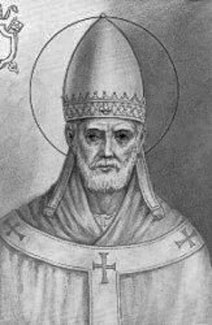| Pope Damasus I  Born: c. 304 AD Born: c. 304 AD
Birthplace: Rome, Italy
Died: 11-Dec-384 AD
Location of death: Rome, Italy
Cause of death: unspecified
Gender: Male
Religion: Roman Catholic
Race or Ethnicity: White
Occupation: Religion Nationality: Italy
Executive summary: Roman Catholic Pope, 366-84 AD Damasus I, reigned as Roman Catholic Pope 366 to 384. At the time of the banishment of Pope Liberius (355), the deacon Damasus, like all the Roman clergy, made energetic protest. When, however, the emperor Constantius sent to Rome an anti-pope in the person of Felix II, Damasus, with the other clergy, rallied to his cause. When Liberius returned from exile and Felix was expelled from Rome, Damasus again took his place among the adherents of Liberius. On the death of Liberius (366) a considerable party nominated Damasus successor; but the irreconcilables of the party of Liberius refused to pardon his trimming, and set up against him another deacon, Ursinus. A serious conflict ensued between the rival factions, which quickly led to rioting and hand-to-hand fighting. In one of these encounters the then new basilica, called the Liberian Basilica (S. Maria Maggiore), was partially destroyed, and 137 dead bodies were left in the building. On several occasions the secular arm had to intervene, although the government of the emperor Valentinian was averse from involving itself in ecclesiastical affairs. From the outset the prefect of Rome recognized the claims of Damasus, and exerted himself to support him. Ursinus and the leading men of his faction were expelled from Rome, and afterwards from central Italy, or even interned in Gaul. They, however, persisted obstinately in their opposition to Damasus, combating him at first by riots, and then by calumnious lawsuits, such as that instituted by one Isaac, a converted and relapsed Jew.
To the official support, which never failed him, Damasus endeavored to join the popular sympathy. From before his election he had been in high favor with the Roman aristocracy, and especially with the great ladies. At that period the urban masses, but recently converted to Christianity, sought in the worship of the martyrs a sort of substitute for polytheism. Damasus showed great zeal in discovering the tombs of martyrs, adorning them with precious marbles and monumental inscriptions. The inscriptions he composed himself, in mediocre verse, full of Virgilian reminiscences. Several have come down to us on the original marbles, entire or in fragments; others are known from old copies. In the interior of Rome he erected or embellished the church which still bears his name (S. Lorenzo in Damaso), near which his father's house appears to have stood.
The West was recovering gradually from the troubles caused by the Arian crisis. Damasus took part, more or less effectually, in the efforts to eliminate from Italy and Illyria the last champions of the council of Rimini. In spite of his declaration at the council convened by him in 372, he did not succeed in evicting Auxentius from Milan. But Auxentius died soon afterwards, and his successor, Ambrose, undertook to bring these hitherto abortive efforts to a successful conclusion, and to complete the return of Illyria to the confessions of Nicaea. The bishops of the East, however, under the direction of St. Basil, were involved in a struggle with the emperor Valens, whose policy was favorable to the council of Rimini. Damasus, to whom they appealed for help, was unable to be of much service to them, the more so because that episcopal group, viewed askance by St. Athanasius and his successor Peter, was incessantly combated at the papal court by the inveterate hatred of Alexandria. The Eastern bishops triumphed in the end under Theodosius, at the council of Constantinople (381), in which the pope and the Western church took no part. They were invited to a council of wider convocation, held at Rome in 382, but very few attended.
This council had brought to Rome the learned monk Jerome, for whom Damasus showed great esteem. To him Damasus entrusted the revision of the Latin text of the Bible and other works of religious erudition. A short time before, the pope had received a visit from the Priscillianists after their condemnation in Spain, and had dismissed them. Damasus died in 384, on the 11th of December, the day on which his memory is still celebrated.
Father: Antonius
Mother: Laurentia
Roman Catholic Pope 1-Oct-366 to 11-Dec-384 AD
Canonization
Requires Flash 7+ and Javascript.
Do you know something we don't?
Submit a correction or make a comment about this profile
Copyright ©2019 Soylent Communications
|